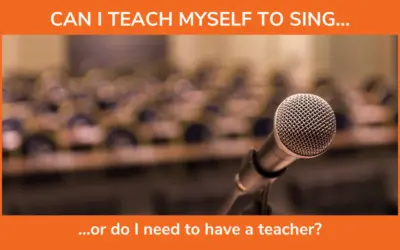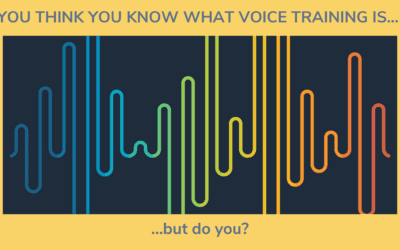Inside This Article
One of the biggest misconceptions in voice work and voice training is the idea that we are a series of parts and pieces (body parts, sounds, localized movement patterns, etc.) that are not connected or part of a larger functional system. And, somehow, by manipulating these parts and pieces we will be able to improve our singing.
So, when we think in parts and pieces – non-systems thinking – we will say things and operate under assumptions like: “the diaphragm supports the voice” (a very common assertion) as if the diaphragm (the big sheet-like, domed muscle beneath the lungs) were a thing-by-itself and could be solely responsible for anything – not to mention vocal function.
And if you think this way, and have this image of how the body/voice/self works, you will sing and/or speak this way. You will sing in “parts and pieces.” That’s how it works. You will try to tweak certain parts of yourself to do things in isolation and try to fix your parts and pieces directly as if they, and they alone, are both the problem and solution in a given situation.
For example, “You’re flat on that note because your tongue is pulling down. Move your tongue up and the problem is solved.” Or “Your jaw is tight. Loosen your jaw.” This is what I call “parts and pieces thinking” and it is seductive because it makes it seem that changing one thing can fix a problem. Voilà! Desired result achieved by doing one “simple” thing… sounds so simple, and let’s face it… marketable!
But is this really true? Is it even possible?
NO!!!
As Josh Waitzkin points out in his beautiful book, The Art of Learning (which I mention in Learning Triggers and Why Singers Should Consider Using Them), there are developmental stages for mastery of a skill – especially when it comes to physical disciplines like singing, martial arts, and sports. And, essentially, these are also the stages of development of one’s understanding of systems – of which we, as humans, are one! – and our ability to interact with our system on the terms of its “systemness.”
Our body/mind/voice/self is a system
THE INITIAL STAGES OF VOCAL DEVELOPMENT:
Josh outlines the stages of going from parts and pieces thinking to basic systems thinking (in a linear way) as follows:
- Understanding the Parts and Pieces
- Connecting and Coordinating different Parts and Pieces
- Understanding the Principles of Coordination
- The Parts and Pieces lose their Individual Identity
So when we attempt to get better at any complex skill, like singing, we can attempt to do that at any of these levels of development. And, for the most part, we don’t really develop our understanding very much beyond where we start. But, if we were to… we would see that “parts and pieces” thinking/singing is just the beginning.
STAGE ONE – PARTS AND PIECES:
Yes, there are parts and pieces. There is a diaphragm. There are vocal folds. There are feet and hands, a nose and a soft palate. Each one has its own kind of structure, logic and a set of movement possibilities. Each one can be differentiated from the other (but NOT isolated!).
This stage can be important for learning, because being able to sense and explore our different parts gives us a sense of ourselves in space (interoception) and a sense of what each part is capable of on its own terms.
It is the backdrop of awareness, both local and global. It’s giving an “address and phone number” for our parts so that we can call them and ask them to do things when needed and/or visit when we want to check in and say “Hi.”
This awareness establishes the basis for what is to come… if we let ourselves move beyond it.
STAGE TWO – CONNECTING AND COORDINATING:
These parts and pieces not only exist on their own, they are connected to each other and can coordinate with each other to do various things together. At first this is on a smaller scale – these two parts together can make these patterns and coordinations which lead to these kinds of outcomes.
This tongue position + that vocalization = this phoneme. OR, these three parts together can do this fancy thing and we start to see many possible combinations with many possible outcomes. To follow the previous analogy, we can organize the parts into blocks, neighborhoods, towns, cities, etc. then re-organize them into different blocks, neighborhoods, towns and cities, etc.
That’s a much more advanced understanding and allows for great access to more possibilities, but it is actually still limited. There’s more!
STAGE THREE – PRINCIPLES OF COORDINATION:
When we play with these combinations and coordinations (with sound and movement, in our case) enough, we start to see that there are certain governing principles at play. For example, there’s “the law of opposites” which observes that, in the human body, when one part goes in one direction there’s usually another part that goes in the opposite direction to balance that out.
Take the lips. When the lips come forward, something in the pharynx (palate, back of mouth area) tends to go backward as a counter-balance. Functional, this is a good thing. It is not tension or extraneous. And it helps us understand the physical patterns of efficient movement and coordination.
There’s a relationship there. For a reason. And, it’s natural. We can override it, of course, but, generally, this is a principle of healthy and easy coordination and can be used to find balance and proportionality in movements of all kinds.
And we can keep exploring this (and dozens of other principles) with the understanding that there are many different parts, patterns, coordinations and principles happening at the same time. So, the lips can be moving forward while the pharynx is balancing backward, while the palate is going up and the pelvic floor is balancing downward, while the arms are moving forward and the back is balancing backward, while the vocal folds are vibrating and altering the pressure downward into the lungs and abdomen… to the diaphragm and vice versa (for all of them)… all at the same time!
And each coordination is affecting the other coordinations too! If we keep going with this, it becomes very complex and beyond our comprehension (other than theoretically)! But, if we keep thinking and expanding our awareness in this way it can lead to the next stage! Because, yes, there’s more!
STAGE FOUR – NO MORE PARTS AND PIECES:
The Parts and Pieces lose their individual identity! WHOOHOO! FREEDOM!
At this point, we start to understand that the lips are not just the lips, the vocal folds are not just the vocal folds, the diaphragm is not just the diaphragm. No part is just a part. They are all part of one WHOLE SYSTEM and can no longer be seen as separate and isolated in any way. Like a Rubik’s cube, when you move one piece, all of the others move too.
And this is happening in the human body/system in all directions at once. Many parts moving move all parts moving… which move more moving… IT’S MIND BOGGLING if you try to understand it consciously, but our awareness and ability to sense (aka our nervous system and brain) can hold ALL OF THIS at once.
That’s what it’s designed to do, actually! It’s like understanding that turning the water on in one sink in one house in one town affects something in another town that may or may not have anything to do with sinks which in turn creates that, which in turn… infinitely.

Now we’re in the realm
of Chaos Theory
Now we’re in the realm of Chaos Theory and Complexity Theory! Because, after all, it’s not just linear and there’s order in the chaos/chaos in the order.
A PARADIGM SHIFT:
Making this shift of thinking is truly a paradigm shift and makes things like vocal exercises prescribed to make one part do one thing to get one sound to occur seem totally silly and childish! There are no parts and pieces, no one-part solutions. We are a system. Our voice is part of that system. For anything to change, all must participate. Proportionally. Connectedly.
Thus, there is no diaphragm. And, if the voice is engaged, of course the diaphragm is involved, as is the entire rest of the system – one way or another. And, each is co-affecting each other.
“This sounds so complex, how could we possibly understand all of this in order to sing better?”
Now, you might be asking: “This sounds so complex, how could we possibly understand all of this in order to sing better?”
Well, the answer is: “You do and you don’t!”
Your system is a system attached to a beautiful brain that once we start respecting the whole as a system and get out of the way and let it do its thing it will improve and learn endlessly! We can become more aware of this process and engage in it in an integrated way in order to support this very fundamental and natural way of learning. But, we cannot control it.
THE SINGING SELF:
And, this is exactly what I do in my SINGING SELF PROGRAM – we look at the parts and pieces because they are there and we can become better acquainted with them, but not on the level of parts and pieces alone, not as an end in itself.
We look at coordination and integration too! We learn as a system with awareness. And, what emerges is a trust in the intelligence of our system to continuously learn and update, grow and serve us better and better as we clarify our understanding and intention to do what we want and sound how we want!
It’s a process, yes, but once you make that paradigm shift, and learn how to learn in this singing-in-systems way… it’s a totally new game; one that is fun, interesting, fascinating, pleasurable and in the end leads to MORE CONTROL than if you tried to control the system by managing it on the level of parts and pieces.
P.S. – According to Josh, there are more stages beyond #4… I work with those in my classes and lessons too! Perhaps that’s for another blog.
P.P.S – 99% of voice training out there is only operating in stage one… MAYBE stage two if you’re lucky. But, NONE of them are truly operating from a systems-thinking and systems-learning point of view.
Just sayin’.
This article is one of a series on the topic of the tongue and how it fits in with vocal learning. Read all about it here:
OH THE TONGUE!: THE CENTER OF IT ALL?





0 Comments